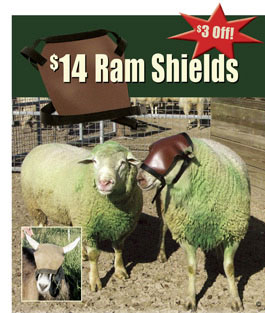Message from the Owner
Sheep vs. Meat GoatsFor those who do not own both species, I'll share my sense of the differences between our sheep and our meat goats. (I've raised Boer goats just 6 years and sheep all my life.) I said "our" sheep & goats deliberately because there are many differences between breeds and between specific flocks/herds within a breed. Diet: Sheep like grass (legumes, grasses, forbs) as much as they do brush and trees. However goats will ignore a field of the finest clover to browse brush. The leaves and branches of willow trees are almost a drug to them—for which they will do anything. Goats will work together to access them (one pulling down a branch while the others eat from adjacent branches). It's easy to see why areas that have had unfenced goats for thousands of years (Middle East, Africa) are often short on trees. No young tree or bush has a chance of survival. Fly-strike problems: Can occur here with sheep. Never with goats. Foot problems: More with goats than with my sheep. Their hard feet wear less rapidly on our soft soils and therefore need more trimming. Handling for drenching, vaccinating, ear tagging and foot trimming:
Lambing/Kidding:
Internal parasites: Both are affected. Our sheep, when badly affected, usually scour and/or develop "bottle jaw" before dying. Our goats just go thin and die. Goats require twice the level of dewormer (per lb. of body weight) to control the same parasite. Fences: All fences that will stop a meat goat will stop a sheep. The reverse is not always true. Goats are more clever at finding weaknesses in your fences, more� agile and more keen to escape (the brush is on the other side). Permanent fences must be taller for goats (45 in. if electrified, 48 in. if not, is our rule of thumb). We prefer woven wire fences and an offset electrified wire on the inside at about 28 in. above the soil. The hot wire keeps goats from sticking their heads through the woven wire (to eat brush on the other side) and keeps them from rubbing on it to remove hair. The only portable electric fence that works consistently for goats is netting (preferably 42 in. or taller). Other: Never leave machinery or trailers parked near goats. Those who do so often find that wires are damaged by the chewing of goats whose curiosity approaches that of monkeys. Best wishes to all, Special Price from Premier!
$14 Ram ShieldsA leather mask that blocks the ram's forward vision. This prevents rams from charging humans or other rams. It does not limit side vision. Rams still eat, graze, breed and drink. It's so effective in subduing belligerent rams that it surprises first time "users" (both the ram and the shepherd). Warning: Never trust a ram. Intact adult male animals simply are not predictable. Never turn your back on even the most friendly. And teach your children to respect and be cautious around them. Rams can and do injure each other during breeding season. But the risk of serious human injury from rams is also not small. The editor of a leading farm magazine turned his back on a ram he'd owned without incident for years. Suddenly the ram hit him from behind and knocked him off his feet. He broke both wrists when he reached out to catch himself. So never trust a ram/bull/stallion/or buck. Polled Shields Horned Shields To get your special price when ordering: Use Code: News 21 Premier VIPPreparing for Kidding With Meat Goatsby Suzanne Gasparotto
Preparing for kidding should start when does are first placed with a buck for breeding. Good management practices—proper feeding, clean water, fresh hay, dry pens, suitable bedding—are part of the larger picture. The must do's cited in this article will put in place tools that the producer needs for kidding to go more smoothly and with less illness and death. This author's website has an Articles page with information on topics related to goat medications, supplies, diseases/illnesses, nutrition, and management. Take advantage of the knowledge provided and contact this writer via email or telephone for additional assistance. Although not a vet, the author has many years of experience in raising meat goats, writes exclusively for Goat Rancher Magazine, hosts several meat-goat discussion groups on the Internet (including ChevonTalk and GoatER, both of which are on Yahoogroups), and each October offers a one-of-a-kind meat-goat educational program GoatCamp™ at Onion Creek Ranch near Lohn, Texas. Readying the FacilitiesEstablish kidding/bonding pens for those problem births which inevitably occur. Five-foot sections of lightweight tubular metal with 4 inch by 4 inch panels welded to them and a gate in one side panel work well. They assemble and break down easily and can be set up in different configurations by removing dividing panels to make larger pens. Provide shelter from wind, rain, and very cold weather. Provide a place where kids can sleep away from dams so they don't get injured by other moms and they don't get crushed. A shed with the inside walls lined with railroad ties at ground level and a narrow bench built above the ties provides a good place for kids to hide. They can get off the ground and sleep on the railroad ties, while dams sleep on the bench above or on the ground near them. The bench needs to be low enough that moms cannot crawl under it. Do not enclose the underside of the bench; kids will pile on top of each other to keep warm and kids on the bottom will suffocate if a vertical wall blocks their escape. All birthing/bonding areas should be free of ants and other pests. Ants can eat the eyes, noses, and mucous membrane tissues of newborn kids, causing permanent damage. Before using ant killer, read the labels and talk with your vet about products safe for use around goats. Amdro is the ant killer used at Onion Creek Ranch. Clean hay should be spread on the ground in advance of using these small pens. Do not use wood shavings in kidding areas. Shavings get into kid's mouths and noses, causing breathing problems, and they also interfere with the ability to clean her newborns by the use of mom's tongue. During very cold or cold and wet weather, consider using reflector heat lamps with bulb guards in areas where kids sleep. Newborns and very young kids have difficulty regulating internal body temperature, but they can usually stand a lot of cold so long as their tummies are full of milk and they stay dry. In areas of moderate cold such as the southern half of the United States, infrared bulbs are usually too hot and some of them produce a very bright light that may be uncomfortable for both dams' and kids' eyes. Keep electrical cords out of reach to prevent kids from hanging themselves or chewing on them. Water buckets should be shallow and carefully placed to avoid a kid's drowning in them. Special provisions must be made during freezing weather to provide warm water to both dam & kids. Learning to think like a goat will help prevent injuries & deaths. Goats are extremely curious animals and this curiosity can get them into life-threatening trouble. Do not overcrowd goats. Goats require more space per individual than most other species of livestock. They stress easily. Since goats have very fast metabolisms, they produce large quantities of urine and solid waste material. Does need space to bond with their kids—to learn their kids' smells and sounds—and kids require the same. Overcrowding leads to filth (concentrations of urine, solid waste matter, and soiled/wasted hay) and filth leads to disease and even death. The two biggest challenges in raising goats in any sort of managed conditions are overcrowding and proper nutrition and the problems which result. This point cannot be over-emphasized. Purchase in advance of kidding the essential supplies. Every item has an important useful purpose. To see a copy of the list go to www.tennesseemeatgoats.com Preparing Does for KiddingOne month before the first doe is expected to kid, de-worm all pregnant does. Do not use Valbazen; it can induce abortions. At the same time, boost the does' CD/T vaccinations. Kids are not born with their own working immune systems; the CD/T booster given their dams both protects the pregnant does and passes immunities to the kids which usually lasts until their immune systems start limited functioning at around one month of age. Clean the does' systems of coccidia parasites by either dosing them orally or in their sole water source for five consecutive days with either Albon or its generic equivalent Sulfadimethoxine 12.5% drinking water solution. CoRid is another product for this purpose, but it is a thiamine inhibitor—don't use it unless there is no other option. Another plus is that both Albon and Sulfadimethoxine 12.5% drinking water solution contain an antibiotic to handle secondary infections. If time permits, trim hooves and tail webs. Hoof trimming is a good management practice. A doe with hoof rot or hoof scald cannot forage/browse well enough to produce adequate milk for her kids. A hairy tail web retains solid waste material & placental matter after kidding. Do not "flush" pregnant does with extra feed immediately prior to kidding. Grain should be very gradually increased during the last month of pregnancy, when fetuses are rapidly growing. Over graining or improperly graining a heavily-pregnant doe can cause several very serious diseases that can kill the doe and her unborn kids. Offer grass hay on a free-choice basis. Feed grain preferably before noontime—especially in very cold weather—and take up any that has not been consumed in 15 minutes. Do not feed extra grain at night. Instead, make extra hay available. As fetuses grow, the size of the doe's rumen decreases. The doe must have sufficient top-quality grass hay to keep her rumen functioning and still permit some room for grain intake. The long fiber in grass hay stimulates rumen wall contractions which in turn creates body heat to keep the goat warm. Feeding grain properly can be a tricky balancing act in managed herds—and particularly to pregnant does. If feeding alfalfa or other legume hay, gradually discontinue feeding it and don't offer any kind of legume hay during the last four weeks of gestation. Legume hay (alfalfa and peanut are examples) are high in calcium. As parturition (kidding) approaches, the doe's body must release calcium from her bones. If she is being fed a high-calcium diet, calcium release from her bones will not happen and Hypocalcemia ("milk fever"—not really a *fever* at all) can occur. Hypocalcemia can be a life-threatening illness for the doe and her unborn kids. Don't forget the importance of exercise to the pregnant doe. Fat does can easily experience dystocia (kidding problems). The time for extra grain is when the doe has kids on the ground and is making lots of milk (lactating). So…with shelter in place, proper hay, grain and minerals available, supplies at the ready, and does in top condition, LET THE KIDDING BEGIN! This article was first published in Goat Rancher Magazine for which Suzanne writes exclusively. You can contact her at Suzanne W. Gasparotto, HC 70, Box 70, Lohn, TX 76852. Visit on-line or e-mail Onion Creek Ranch at: www.tennesseemeatgoats.com or onioncreek@tennesseemeatgoats.com Premier TipInserting Ear Tags in Cold WeatherPlastic ear tags (all brands) are much easier to install if they are warm. Why? As the temperature drops below freezing plastic becomes less flexible (more stiff) and forcing the male point of a tag through the female takes many more lbs. of pressure (because the female must expand). So if you care about your hands it's a good idea to keep the tags above freezing in very cold weather. It takes very little to do this. One method is to simply store them while tagging in a small bucket, cardboard box or tool box with a lid alongside a sealed pop bottle full of warm water. The warm water will keep both the air and the tags warmer in the container. Premier Employee Spotlight
Frank WalkerAn all around good guy is this month's featured employee. Frank Walker is from Wellman, Iowa and has been with Premier about two years. His primary responsibilities include servicing energizers, assisting in our shipping department and helping to take care of Premier's farm and our multitude of animals. He enjoys the daily diversity and the friendly folks that he works with here at Premier. His significant other is Lyn and their children, Jolee, six and Olin, five. They have lots of critters at their place which includes a dog, 2 cats, 2 baby goats (Scurvey and Scooter), a turtle named Speedy and Rascal the raccoon. Frank rescued Rascal from a tire as a baby and now has the run of his place, but comes up for friendly visits. Frank enjoys hunting of all types but especially pheasant hunting, fishing and camping. He says "that his favorite place to camp is where no one else is and if the bass and catfish are good." Not much on words, but with a mischievous sense of humor, Frank is a great person to have around Premier. RecipePizza CrustIngredients: Mix yeast in warm water. Add the rest of the ingredients. Knead dough. Let rise until doubled. Pat out dough on stone or roll with rolling pin. Add sauce, meat, toppings and cheese. Preheat oven at 425 degrees and bake for 15 - 20 minutes. – from Premier employee, Sara McArtor. |





